Things were going so well as summer became autumn 1985, although thinking about it, maybe therein lies the problem… Summer Games II had seen some fantastic coverage as it built up to what was originally heralded as its upcoming August release that year. Flicking through copies of Computer & Video Games magazine around the time, there were full-page hands-on previews, and there were competitions, and they all showed various sumptuous screenshots of posh people doing horsey things that, looking today, aren’t a million miles from what Defender of the Crown was doing on the Atari ST and Amiga a few years later, and then there was the almost photo-realistic high jump contest that put my dear old Daley Thompson’s Decathlon on the Spectrum to shame!

As autumn was becoming winter 1985, business really picked up when these beautiful double-page adverts starting appearing too, as Olympic in stature as the game was in scope according to the accompanying blurb, which was backed up by the most glorious screenshots we’d seen yet, showing the lit flame of a dramatic opening ceremony, cycling, kayaking, more high jump and some horsey stuff in action this time! Not least, though, were the insane ZZap!64 magazine review scores… Presentation 99%. Graphics 97%. Sound 96%. Hookability 98%. Lastability 97%. Value 98%. Overall 97%. Wow! Capping off the advert is something I’d never really noticed before, but there’s some lovely brand cohesion (not to mention very eighties design!) where Epyx’s other titles are shown side-by-side, with the original Summer Games joined by Impossible Mission, Pitstop II and, er, Breakdance! Some of the very best of the Commodore 64 right there, and, er, Breakdance! Joking aside though, I remember the review of that in one of the very first issues of C&VG I bought, and I’ve always fancied it…

With Breakdance on Commodore 64 now firmly ensconced in my big list of games to cover here with a deep-dive of its own (and I’m not joking!), let’s finish off our look at that big fancy advert with the very last words it speaks: “And coming soon… Winter Games.” And therein lies the real problem, at least as far as my best friend and the brand new Commodore 64 he got for Christmas mere weeks after this was concerned! C&VG’s own review of Summer Games II on the Commodore 64 finally came in the December 1985 issue, with a little expert help from British and former Commonwealth heptathlon record hold Judy Simpson, who seems to have mostly liked saying that graphics are as good as the arcades whatever game she was reviewing here! Anyway, to set the scene, it’s a bunch of sports reviews, with Summer Games II and the now-released Winter Games sharing equal billing on a big double-page spread that also featured Hypersports on the C64, Spectrum and CPC (which I will also feature here sometime as it’s an all-time favourite!) and Daley Thompson’s Super Test, and if you thought its predecessor’s high jump was being put to shame before, wait until you see this tug-o-war Spectrum screenshot in the midst of all this Epyx greatness!
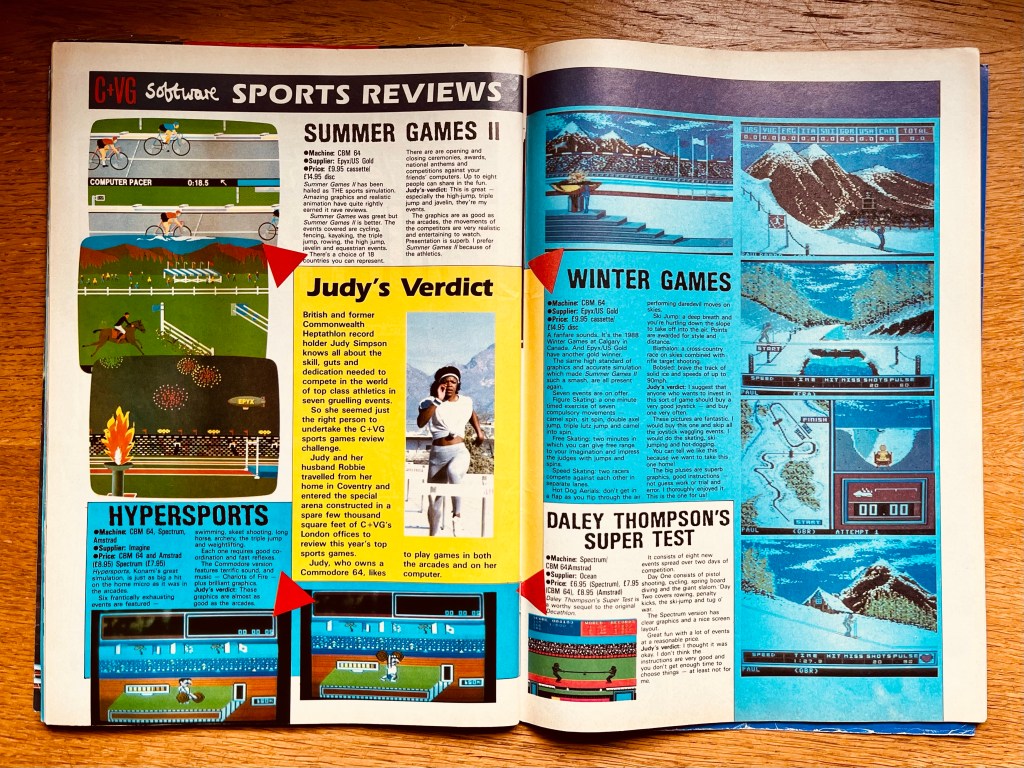
Hang on just a second though. It might be two monochrome figures at each end of a rope, but at least it’s an actual screenshot! Of the three Summer Games II screenshots on this page, on closer inspection, none of them appear to be more than illustrations – possibly by the same artist who did the screenshot in the Commando advert around the same time! No amount of brown sky is fooling anyone into thinking these are C64 screenshots, especially when the genuine articles are on that advert looking totally different in the same issue! You know what though, it really didn’t matter, because across the page, and before you’ve even read Judy’s verdict (which is clearly based on never having played the game because she’s talking about pictures of it looking fantastic), are some of the most stunning alpine landscapes to ever grace any computer screen, let alone a C64’s! Just check out that opening ceremony too – you can’t fake that, and if you’ve just got a C64 then there’s only one game you’re buying out of these two, whatever Judy says!
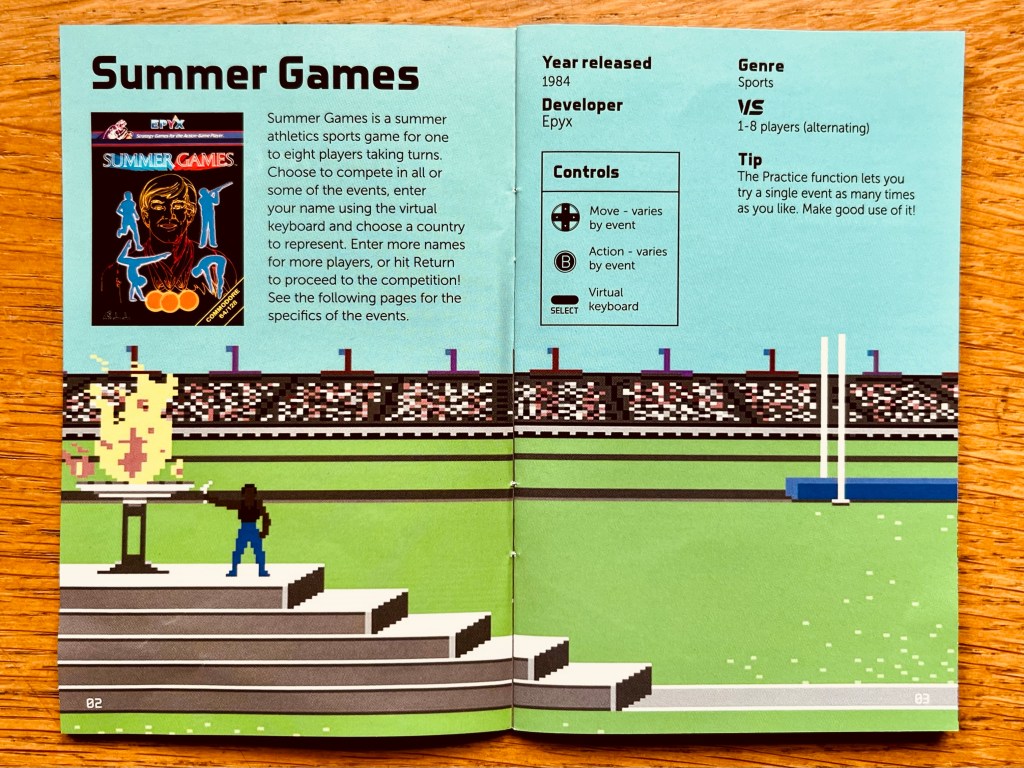
And with that, my lifelong love of Winter Games, and subsequent Games games, such as California Games, was established, but to this day, I’ve never played Summer Games II. Which is why we are here! I did eventually get to its predecessor though, care of The C64 Collection 1 cartridge on Evercade at the end of 2022, and actually that’s another reason we’re here because I had such a good time getting to know it I decided its sequel deserved a chance too after all this time! The original Summer Games appeared in 1984, kicking off the Epyx “Games” series that would span the sequel, Winter Games, California Games and World Games as what I’d call core entries, then The Games: Summer Edition and Winter Edition, which beefed up what was on offer previously in time for the 16-bit computers, while several of the others would also see console releases over the next few years. California Games also got a sequel but it didn’t really make many waves this time, which was literally why I didn’t buy it – I was always all about the surfing in the first one!
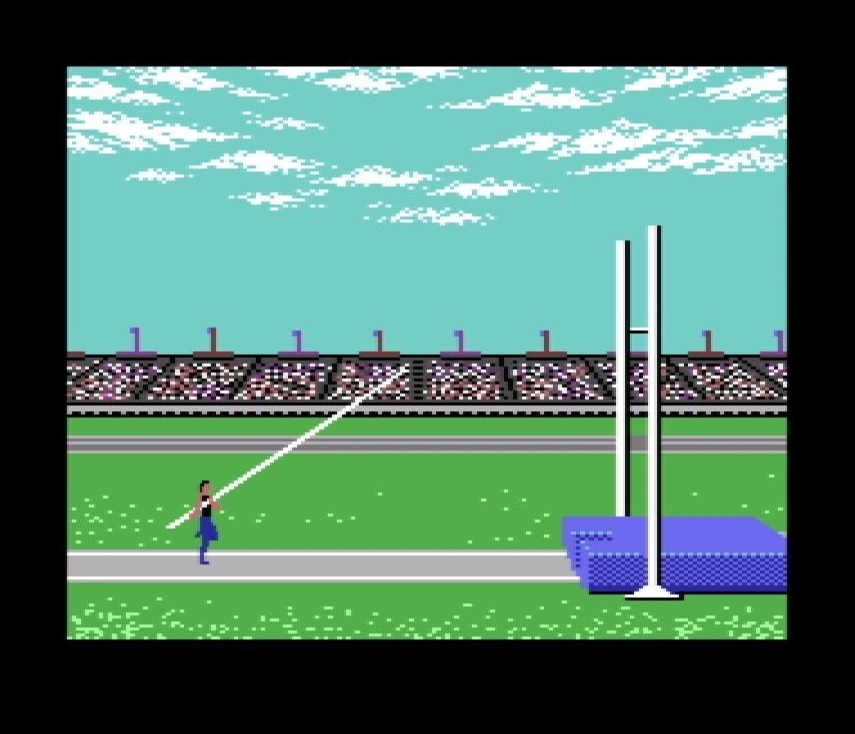
Unlike its own sequel (at the time at least), Summer Games came out on most stuff around in 1984 – the usual C64, Spectrum and Amstrad CPC versions, then the Apple II, Atari 8-bit and its 2600 and 7800 consoles, and eventually all the way up to the Sega Master System. Never got a 16-bit computer release though. Anyway, as was often the case with these, the number of Summer Olympics-themed events on offer did vary depending on the platform, but if we’re talking the C64 version I know, then we’ve got diving, 4x400m relay, 100 metre dash, skeet shooting, pole vault, gymnastics, freestyle relay and 100m freestyle, both of which were swimming events. Apart from the 100m, it’s all about timing rather than joystick-waggling, and except for the freestyle relay, which just outstays its welcome a bit because it’s identical to the 100m but four times longer, that works great for me! You absolutely need to read the instructions though because every event works differently, and also in common with in successors, while not massively complicated, it’s not always massively intuitive either! Lovely presentation throughout though, and in the unlikely event you can get an equally-schooled friend to compete against (or in my strange case, even if not), still a real blast today!
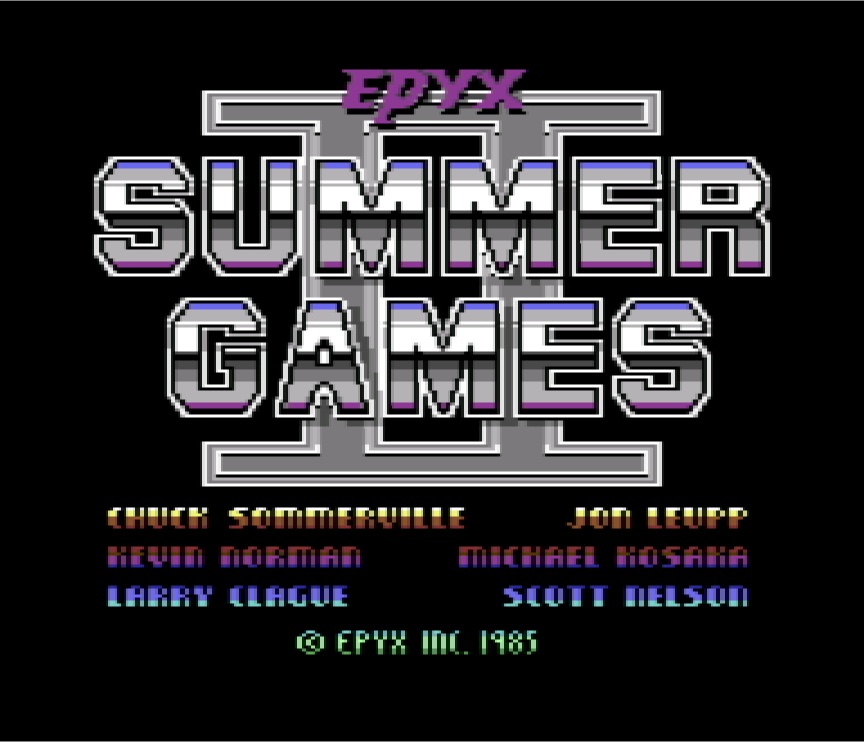
And with that all established, let’s move on to its 1985 sequel, Summer Games II. “You are about to compete against the world’s best athletes in a 3,000-year-old competition. The pinnacle of athletic achievement. The Summer Games.” Looking at the original instruction manual, there’s an insane amount of guff about walking in the footsteps of Jesse Owens, and the “majesty, scope and glory” of the original game, and being heralded as the best ever, but all you really need to know is you’re competing with up to eight players across eight events – cycling, equestrian, fencing, high jump, javelin, kayaking, rowing and triple jump. You can practice them all or individually, or when you’re ready to compete, you each enter your name and pick one of eighteen countries (or just “Epyx”) to represent then go through the lot, one player at a time, with medal tallies and world records recorded (which, as a solo player, is where I tend to get my longevity from these things nowadays). There’s also a very cool option to add the original Summer Games events, giving you a total of sixteen here, if you own it!

I’m sticking with the regular eight today though, but before we get into each event, I should also mention the opening and closing ceremonies, both of which can also be accessed anytime from the main menu. They’re lovely, animated cut scenes, featuring the dude with the torch running and lighting the big flame before a load of doves are released into the air to kick things off, and at the end you’ve got day turning to night as the flame is extinguished before a bloke on a jet-pack flies about ahead of an airship flying by and a big fireworks display. And they’re both a mark of the polish you can expect throughout here, although there really is a limit to how many times I want to hear the SID chip spew out any country’s national anthem, let alone some of the more “imperial” ones!
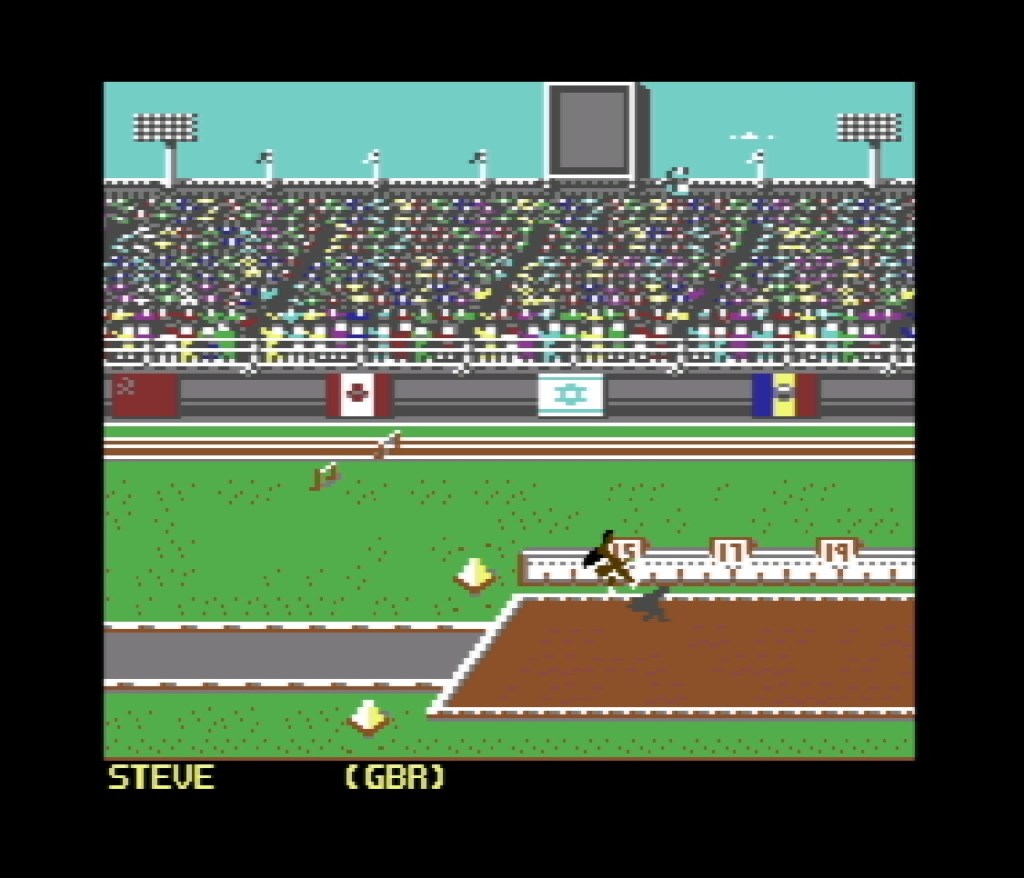
Opening ceremony out of the way, the first event is triple jump, and what I do want to hear is the superb piece of music that accompanies your athlete as he stands waiting for you to press fire to start his run, which you’re going to discover in every other event too, with each getting their own very accomplished theme. I also love the way the instructions now pick up the commentary before giving you the controls… “The stadium is alive with excitement as the athletes prepare to compete in the first track and field event!” That’s all well and good, but things get less welcoming as you read on, and even more so as you try to play because this event has some seriously finicky controls! This one is all about the timing, and you have to be absolutely spot-on with what are some of those less than intuitive controls I mentioned that apparently relate to whichever foot the action is currently on! Thankfully, no joystick waggling though, as you automatically build up speed then press right to hop, right again to step – the split-second your foot touches the ground to land – then left to jump, again, with split-second timing. Move too late and it’s a fault, meaning one of your three attempts gone.

This event is absolutely brutal, and no matter how many times I play I’m struggling to consistently land in the sand pit more than once out of my three goes! And given that, how far you actually travel when you do nail all three movements seems a bit hit and miss – I guess distance is down to precision of timing but the window for succeeding is so tiny and therefore so binary that it all seems random to me. However, for all its difficulty there are two exquisite examples of the game’s attention to detail to highlight already; firstly, the wonderful animation as your guy realistically rocks back and forth to build himself up to his run-up, and secondly the big screen showing this gorgeous, classic C64 blocky pixel art action replay of your jump once you’ve landed! Just putting myself back into a 1985 mindset, this is way above and beyond expectations from a game at the time… Unlike the multiload, which is already driving me mad even using emulation!
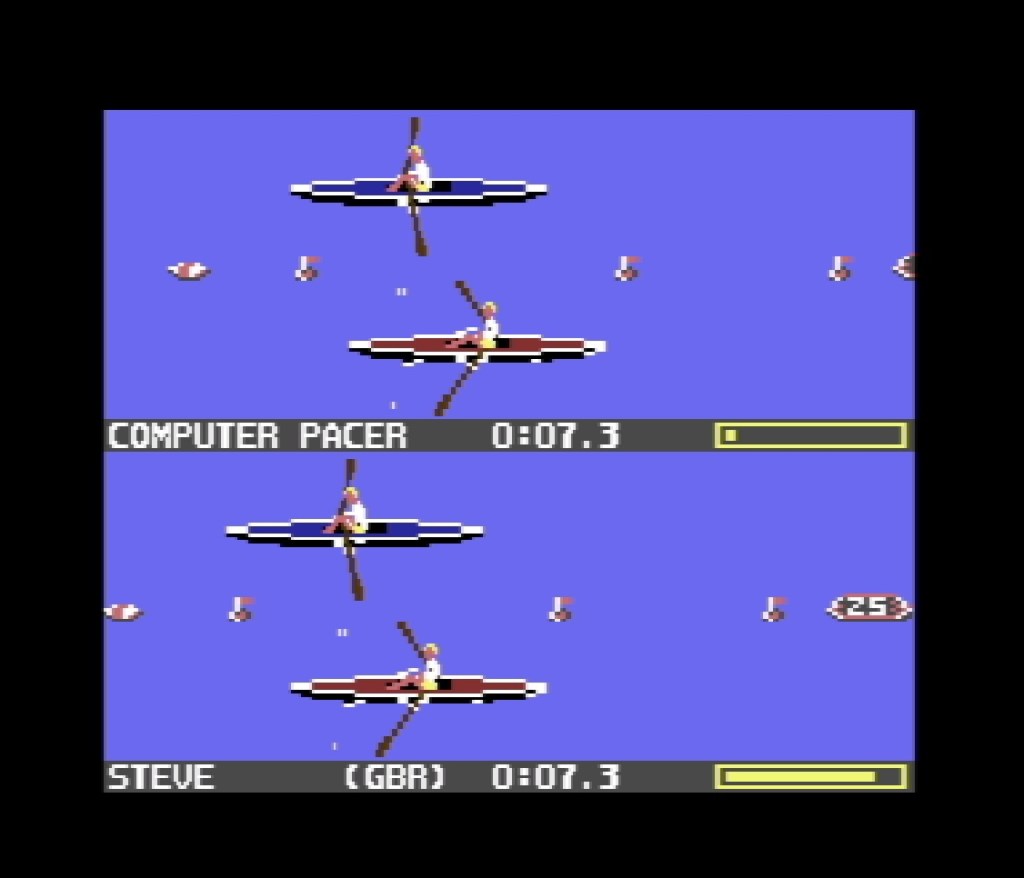
Speaking of which, I was only planning on one paragraph per event because I’m sure you’ve got better things to be doing, so let’s load up rowing, or specifically the single sculls event, where it’s you in a solo canoe racing against an opponent, and you need to row with left and right, building up the optimal rhythm to get your oars moving through the water as fast as possible. This one’s far more basic to look at, with a split screen showing each player’s boat in its lane on a plain blue background and the opponent’s next to it (when it’s close by), meaning possibly four boats on the screen at once but you soon learn to focus on what you’re doing. And what you’re doing is almost meditative once you find your groove! It’s all about consistency over pace of movement, and that’s surprisingly hard to maintain over the forty seconds or so you’re racing, meaning regular panicked and not at all rhythmic motions to it get going again! I like the speed skating event in Winter Games, which would follow this template, and I like this just the same. It’s simple but it’s entirely on you to get it right.

We’re back in the stadium for the javelin, and this guy can’t wait to get going! He’s nervously rocking back and forth, desperately waiting for you to press fire to run, and while the javelin looks a bit otherworldly, his shadow is following his movements really impressively! This time, you’re pressing fire to build up speed along the track, although it’s very short so there’s only so many times you’ll be pressing. Once you’re near the end, push left to pull your arm back and wait for the optimal angle to push right and let fly, with a fantastic and very realistic little leap at the end as it soars away! Run too far and it’s a fault, and you get three goes to get your best distance. The detail in the stadium (versus blue for water) definitely brings these track and field events to life almost as much as the clever character animation, but unlike the triple jump, this event really puts you in control; no angle readout like in Decathlon either – you need to be the judge of where 45 degrees is here! This, combined with very intuitive controls for a change, and plenty of room for precision, makes it another really enjoyable event.

Despite literally living in horse central – so much so it’s where all the horses that competed in the 2012 London Olympics were housed – and being able to see three of them from where I’m sitting as I type, I know absolutely nothing about horses or this equestrian show jumping event we’ve got next! Does look awesome though, even if the horse is lacking a bit of the detail that’s present in the rider, with his smart mix of black and white riding gear. The animation is alright too, if not quite reaching Kane levels of Commodore 64 horse animation greatness! It’s all relatively simple once you know the moves, with you controlling your horse over an impressive variety of jumps against the clock. You push up to speed up, then it’s right to jump and left to stop the horse falling as you land… That “as you land” thing similar to the triple-jump, albeit slightly more forgiving! Time either wrong and the horse will either refuse the jump or fall into a heap, but fortunately there’s no weirdos hanging around each jump with a load of black tarpaulin, and you simply need to back up the horse and try again, but get penalised for refusing or falling too many times and you’ll be disqualified. Never a good sign when the instructions tell you “this is a very difficult event” but I’m kind of neutral on this one – the speed control is hard to get just right, and you’ll often find yourself totally out of control because it’s way too easy to go too fast, but being able to anticipate what’s coming after a few goes does help.

We’re for the high jump next… “A cheer wells up from the crowd as you approach the high-jump bar for your final attempt. Already you have shattered the record. Two and a half meters…” And so it goes on again! At least once you know what you’re doing you can avoid the amateur dramatics of the instruction manual, but what you’re doing first is deciding if you want to jump at the current height or wait for the bar to be raised, then you’ve got three attempts at getting over it. You do this by pressing fire to start your run up then pushing right to run faster, up to move closer to the bar, down to widen your angle of approach to the bar and then fire to jump. Once you’re airborne you then need to push up again to flip up and over the bar. While there are a few variables to consider on the way to the jump, it’s not rocket science but is definitely one you’ll need a bit of practice on. Once you’ve got it, though, there’s a really fun challenge to be had here! I think it’s one of the better looking events too, with smooth scrolling, fluid and realistic animation, and loads of primitive but effective detailing and shadowing. You can see why it was used in the promotional material!

En garde! Fencing falls into the same camp as horse jumping for me – could not care less about it in real life! I think it’s way too complicated for this game too… It’s in the format of a round-robin tournament (depending on the number of players) where you have to score hits by successful landing a thrust on an opponent, and you win by either scoring five hits or by scoring the most hits when three minutes is up. I’ll do my best to summarise how this all works – you’ve got attack and defence moves, and to attack you hold fire and move up to thrust with your foil (sword) and return to a defensive posture, while down will thrust and advance, and left and right move you back and forth across the fencing piste, as I’ve just learned its named! Defending involves moving the joystick up or down to the same level as your opponent’s foil to parry, or left and right to position your foil to the extreme left or right, where you can then make a sweeping motion with your foil by pushing in the opposite direction. If you got your defence right, you’ll immobilise their foil for a second meaning you can have a thrust instead. Way too much going on there for me though, and I just don’t like this event enough to make much of an effort – in the heat of combat, such as it is, all of the above just goes to pot anyway, and it’s the luck of the draw who connects first! I do like the sound effects here though – in the main, it’s white-noisy crowd effects or running or oars hitting water, but here you’ve got some really crisp metal on metal effects! Really not a lot to look at though, which suits the mundane gameplay!

Up until now I’ve been happily playing with a Nintendo Switch Pro Controller, but if you don’t want instant but prolonged hand cramp you’re going to want to either go old-school with a joystick or grab an arcade stick because rotating a d-pad is no fun very quickly! First up though, shoutout to the graphics on this one because I think this captures a cycling sprint perfectly, with the action focussed on the two (or four, if you’re on the same bit of track) big, detailed and realistically animated riders on their bikes, with some colourful and nicely textured track scenery just adding enough flavour on top. It’s a clever control scheme too, with you rotating your joystick (ideally) to the rhythm of the pedals, also indicated by a subtle rotating arrow to follow at the bottom of your bit of split-screen – it kind of replicates the feel of frantic waggling without the damage to the joystick! Okay, there’s not a huge amount to it but, like the rowing event earlier, which it’s a nice twist on, is a really enjoyable fifty seconds or so that demands a level of concentration and coordination to keep things moving with a flow. Great event and loads better than stupid sword fighting!
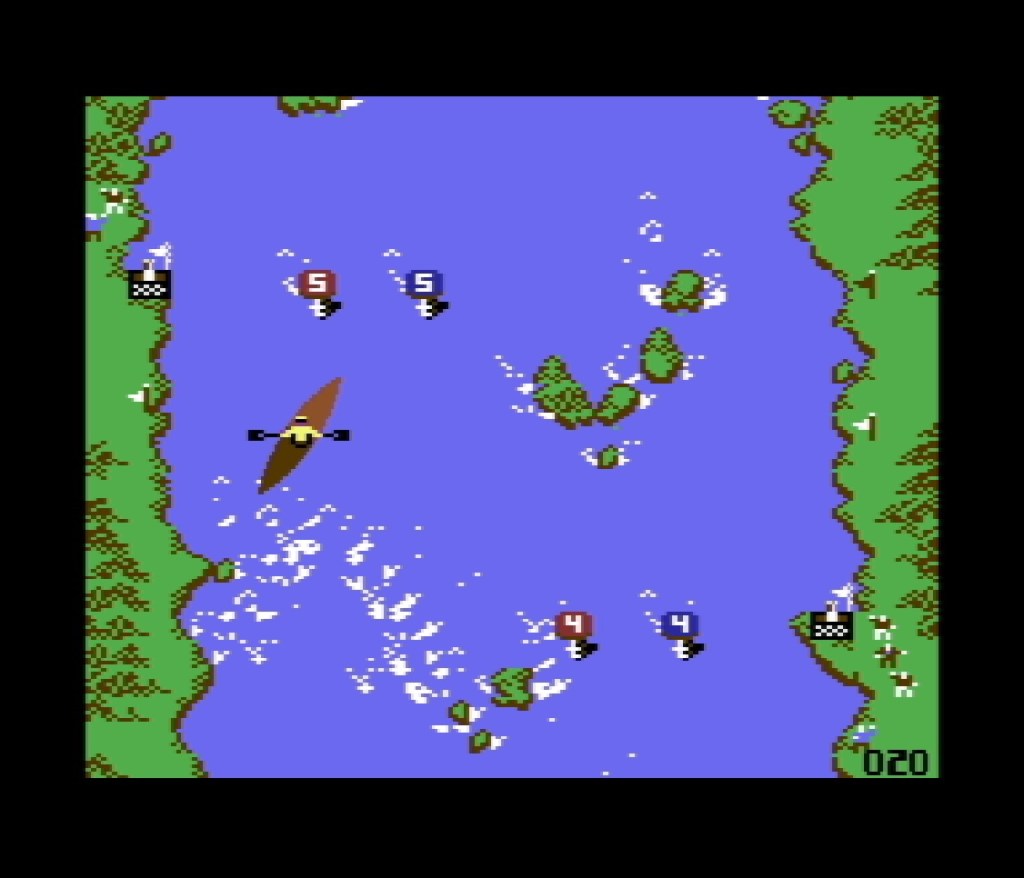
We’ve got one event to go, and that’s kayaking! What really struck me when I got to this one was the variety of environments on offer as a whole, with the impressively detailed and lifelike packed stadium obviously holding everything together, but the events outside of there have a real identity too, and they’re all so polished – way more so than pretty much any other game I can think of where that sport might be represented independently! Truly groundbreaking presentation for the mid-eighties, with so much attention given to the details, whether in the closely-related Impossible Mission standards of animation, the texture in the backgrounds, the colour in the crowds or the realism of the floodlights… And I still can’t get over the big-screen replays that make the triple jump just about bearable! Anyway, kayak, and this really is a looker too, with some great water effects, bold colours and thoughtful waterfront details scrolling by as you travel up the screen.

There’s a great feel to the water too, not dissimilar to something like Toobin’ several years later, and actually that’s not a bad reference point for this event overall, including the somewhat esoteric controls that eventually click and you then wouldn’t change them for the world! Unlike the fencing, for example, though, I’d call it depth over complexity for this event, with left and right doing just that while up and down are controlling your paddle. However, to move forward, pushing up once is a single paddle, so you need to keep doing it, in combination with the directions. And all the while you’re at the whim of those fantastic water physics, as well as the directions being given on each gate you have to pass through, instructing you to either go straight through, reverse through or go through from the opposite direction. Fail and it’s a time penalty, and once you’re done you get a recap of your performance at every gate. This one is hard, it will give your hands a proper workout and it demands some learning, but do that and you’ll get your reward with an event that really could have been plucked out and released standalone!

From there, it’s that closing ceremony we also opened with, and the all-important points tally, where five points are awarded for each gold, three for silver and one for bronze. And that’s Summer Games II! Looking at this crowning of the grand champion, there’s no denying the game works best multiplayer, and just taking that last kayaking event alone, there’s also no denying that to get the most out of it, everyone needs to be decent. Which is why I treasure the endless four player sessions of Winter Games we used to have so much! But that hasn’t stopped me going back to that solo all the time, all these years later, and likewise California Games, and more recently it’s also been the case with this game’s predecessor. I reckon over time it will be to an extent with this one too, playing for world records but mostly just enjoying the events, but I do hesitate slightly because just thinking about fencing again… Makes me groan even more than starting the universally unwanted second ice skating event in Winter Games! Only marginally less so for equestrianism too. I would like to get to know the rest a lot better though, and even triple jump because I’m sure that if you play enough there’s something instinctive buried away in there! Anyway, most of all I’m glad I’ve finally found Summer Games II, so maybe we’ll do the same with World Games sometime and complete the set!

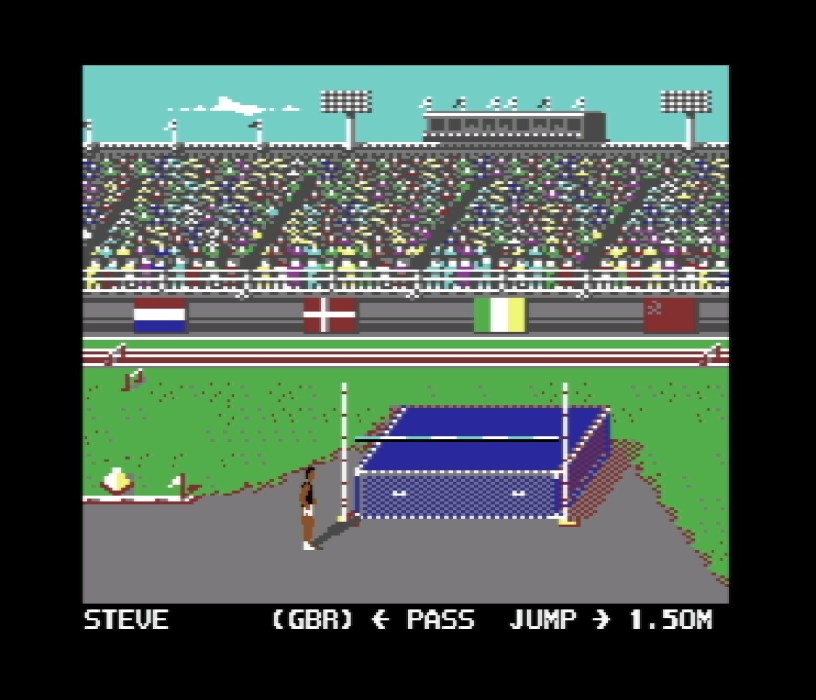
The old trend of using hand-drawn fake screenshots is always hilarious to me — it was obvious even back in the day that they weren’t real, yet they still did it, even on game packaging in some cases! I guess it’s partly down to the fact that actually taking screengrabs back then was an awkward, cumbersome process — a darkened room, a camera set up just right and a black cloth were essential parts of it, as I recall, and even then you had no guarantee you’d get it right — but it still amuses me.
I like the Epyx “Games” games a lot to this day, mostly for the fact that for the most part they resist being waggle-fests. While that makes them harder to learn, with each event having its own *very specific* controls (ones which we’ve taken care to include in the Evercade manuals!) it does provide a fun feeling of skill and mastery when you truly get the hang of one of them — particularly the tricky timing-based ones like triple jump and high jump.
Oh yes, and the music. The music in these games was so good. I’d often hold off on starting an event for quite some time just to enjoy those excellent tunes!
LikeLiked by 1 person
It’s where you’ve got the same screenshots as the hand-drawn ones in the same magazine that gets me, but yes, I guess you’re right, it was laborious, especially if you were getting someone to come up with an advert who probably weren’t sitting on all the computers and a means of getting decent pictures. And no worse than C64 shots on the back of a VIC-20 box!
I always appreciate the Evercade manuals for making these games more accessible – the original manuals did like the sound of their own voice!
LikeLiked by 1 person
Summer Games 2 looks fantastic.
When I was a kid my parents got me Dragon 64 because my cousin had one. Right tight git with games. Anyway it broke on Christmas day dad said I will get you a beeb if you wait a year. By about May I wanted a C64 dad said no got my beeb which was great but always missed the C64.
So many great games I missed out on loved Goonies and Bruce Lee. Played them on emulators though.
Must say the pickup ability of my Steamdeck has really got me back into games. I will give Summer games 2 a go looks so good.
Thanks for all the blogs so interesting
LikeLiked by 1 person
Thanks so much! Make sure you find the instructions and you’ll have a great time. Same for Winter Games. Work great handheld too because almost no joystick waggling required!
LikeLike